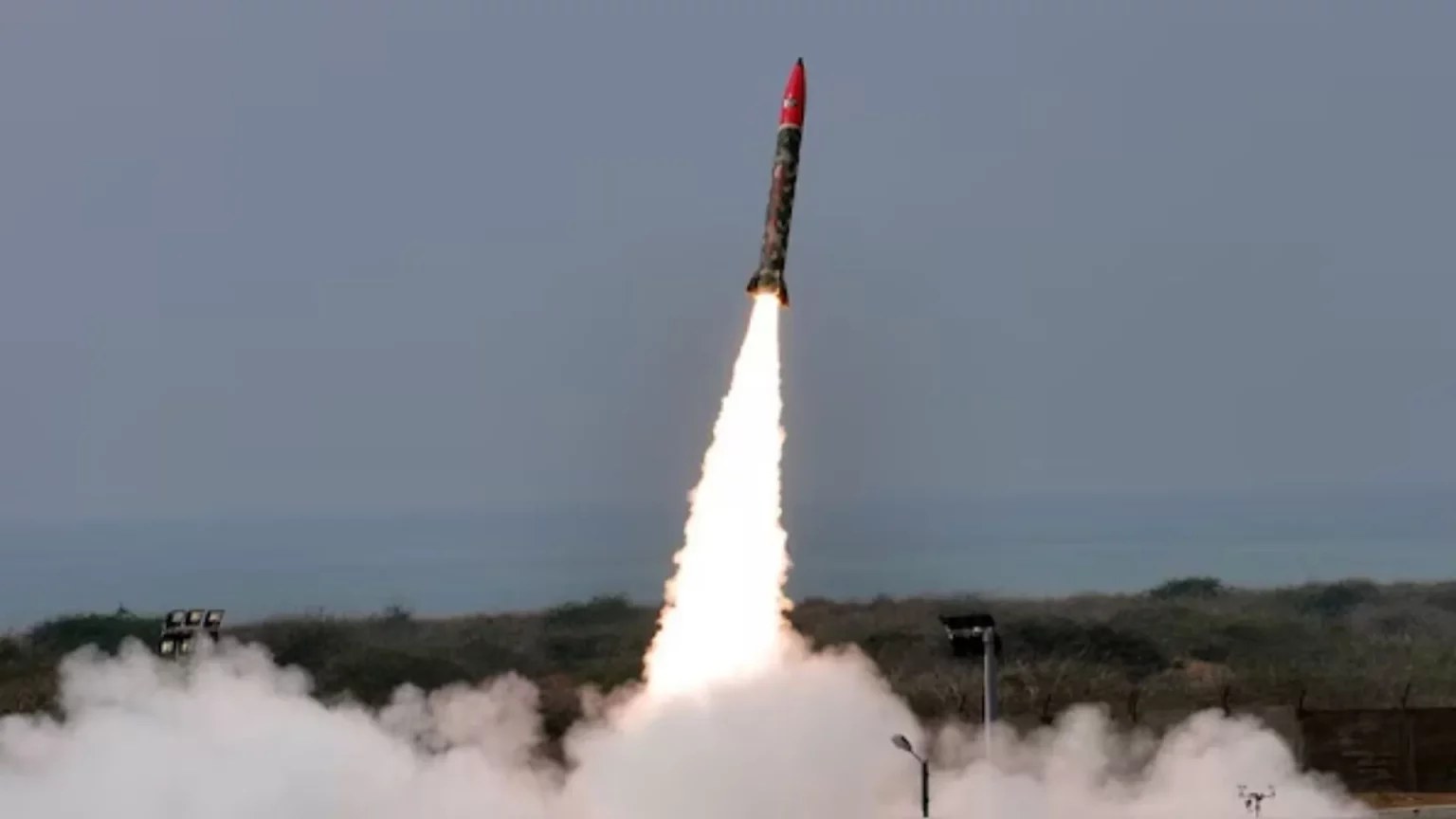Table of Contents
In a big escalation on the India-Pakistan border, Pakistan launched a Pakistani Fatah-1 missile at dawn today, targeted against India’s national capital, New Delhi. The missile, presumably as part of a larger offensive targeting multiple cities, was intercepted and downed successfully by India’s strong air defence system over Sirsa in Haryana.
This is being reported as the first-ever direct Fateh-1 missile attack on Delhi, heightening tensions in the area. The Indian Ministry of Defence confirmed the attempted attack and lauded the quick interception by the S-400 and Akash air defense systems.
What is the Pakistani Fatah-1 missile?
Fateh-1 (also spelled Fatah-1 or Fattah-1) is a short-range guided artillery rocket system produced by Pakistan. It is one of a newer series of missiles intended to equip the Pakistani armed forces with precision-strike capabilities.
| Specification | Details |
|---|---|
| Type | Guided Artillery Rocket (Conventional) |
| Range | 140 km |
| Warhead | High-explosive, fragmentation |
| Accuracy (CEP) | ~10 meters (High Precision) |
| Guidance System | Inertial Navigation + Satellite Guidance |
| Launch Platform | Mobile Truck-Mounted Launchers |
Intended for rapid deployment and tactical attacks, Fateh-1 can engage in strikes against enemy logistics centres, airfields, and radar sites close to frontlines. Due to its flat trajectory and guided nature, it is more challenging to intercept, but India’s air defence was ready for the task.
How India Thwarted Pakistani Fatah-1 missile Aimed at Delhi
Early on Saturday morning, Indian surveillance radars detected an incoming threat from western Pakistan. The trajectory showed the Fateh-1 missile heading towards Delhi, with Sirsa (Haryana) falling within the expected flight path.
India’s Response:
-
S-400 Triumf system locked onto the missile within seconds.
-
Akash SAM batteries engaged the projectile.
-
Missile was destroyed mid-air near Sirsa, preventing any civilian or infrastructural damage.
This successful interception is being hailed as a military and technological success and has reinforced confidence in India’s multi-layered air defence strategy.
Pakistan’s Escalation: Drone Attacks, Multiple Missiles Targeting Cities
Pakistan’s aggression didn’t stop at a single missile. In the last 72 hours, it has:
-
Attempted multiple drone incursions across the Line of Control (LoC) and international border areas.
-
Targeted Indian cities including:
-
Jammu
-
Srinagar
-
Amritsar
-
Pathankot
-
Udhampur
-
Jalandhar
-
New Delhi
-
Sirsa
-
All missile and drone attacks were neutralized by Indian forces. The Ministry of Defence has issued a strong statement condemning the escalation.
Fatah-1 Missile’s Recent Escalation and Attack on Delhi
On May 10, 2025, the Fatah-1 missile became a point of concern after Pakistan allegedly launched missiles targeting India, with the primary focus on cities such as Jammu, Srinagar, Amritsar, Pathankot, Udhampur, and New Delhi. Pakistan reportedly fired several missiles aimed at India’s key airbases and cities. However, India’s advanced air defence systems, including the S-400 Triumf and Akash missile system, successfully intercepted and neutralized the threats.
Missile Strikes in Haryana:
One of the Fatah-1 missiles aimed at New Delhi was shot down by India’s air defence in Sirsa, a district in Haryana. The incident has raised concerns about the growing use of ballistic missiles for targeting urban centers and the challenges of missile defense systems in urban warfare scenarios.
Pakistan’s Escalation with Drone Attacks:
In addition to missile strikes, Pakistan has ramped up drone attacks, further endangering civilian lives in areas such as Haryana and Himachal Pradesh, especially along the International Border (IB) and Line of Control (LoC). The strikes have been aimed at both military targets and civilian infrastructure, including a Hindu temple in Jammu.
Fatah-1 Missile vs Indian Missile Defence Systems
India’s Defence Systems:
India’s response to the missile and drone threat from Pakistan has been robust, with systems such as the S-400 Triumf and Akash missiles playing a pivotal role in neutralizing incoming threats.
-
S-400 Triumf: A long-range air defence missile system capable of intercepting missiles at a distance of up to 400 kilometers. The S-400 system, deployed by India, is considered one of the most advanced systems in the world, capable of tracking and intercepting multiple ballistic missiles simultaneously.
-
Akash Missile System: This medium-range surface-to-air missile system, capable of striking targets at up to 30 kilometers, provided essential coverage during the missile attack.
Impact on Haryana and Himachal Pradesh
The Sirsa (Haryana) missile interception was in the news as the Indian air defence system averted a possible catastrophe. With missiles approaching New Delhi, the successful interception averted major damage to the capital.
Himachal Pradesh, with its strategic location near Jammu and Kashmir, also has potential threats. The escalation has increased security levels, with added vigilance along the border regions.
Haryana:
- Sirsa has remained an important location throughout the missile interception, indicating its role as a key location in the defense system.
-
Incidents of drone activity and threats from missiles have increased readiness to defend against such threats along the border districts in Haryana.
Himachal Pradesh:
- Although Himachal Pradesh was not the target itself, being close to Jammu and Srinagar positions it as a likely hot spot in regional tensions.
- Air defense systems are in a state of high alert, and advisories for increased vigilance have been issued by officials in response to possible attacks.
Pakistan’s Growing Missile and Drone Capabilities
Pakistan’s employment of Fatah-1 missiles and drone attacks reflects its continued attempts to upgrade its missile capabilities and increase its strike range. The Fatah-1 missile is one component of Pakistan’s broader missile defense program, which also includes the Shaheen and Ghauri series of ballistic missiles. The increasing number of drone and missile attacks reflects a trend toward asymmetric warfare, in which Pakistan attempts to counter India’s conventional military superiority by attacking both military and civilian infrastructure.
The Strategic Significance of Fatah-1 Missiles
Tactical Impact:
The Fatah-1 missile is intended for tactical purposes, enabling Pakistan to target deep within Indian territory with accuracy. Its short-range and mobile launch system capabilities render it hard to intercept and neutralize in real-time, making it more effective in military operations along the Line of Control (LoC).
Escalation Concerns:
The deployment of Fatah-1 missiles, in addition to drone penetrations, is an escalatory strategy by Pakistan against India. Attacking civilian targets is a sign of growing militarization in the region, with both states fielding sophisticated missile systems to counter the other.
Conclusion
The Fatah-1 missile has emerged as a central issue in the current India-Pakistan conflict, particularly following recent missile tests targeting major cities. Pakistan’s missile and drone capabilities are still expanding, but India’s air defense systems have thus far been extremely effective in countering these threats. The escalating tensions in areas such as Haryana and Himachal Pradesh highlight the strategic significance of missile defense and regional security cooperation in containing the volatility of the region.


 World Summit on Disaster Management (WSD...
World Summit on Disaster Management (WSD...
 Domestic Systemically Important Banks (D...
Domestic Systemically Important Banks (D...
 The Missing Link in India’s Critical M...
The Missing Link in India’s Critical M...

























